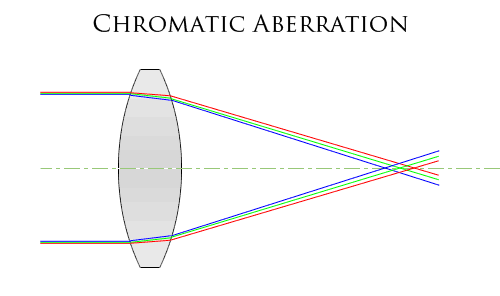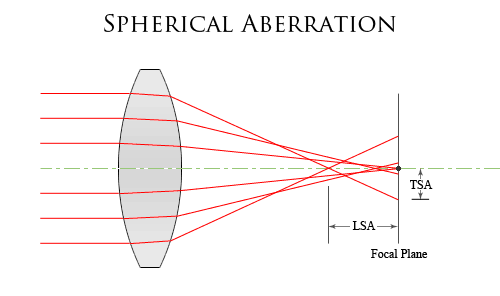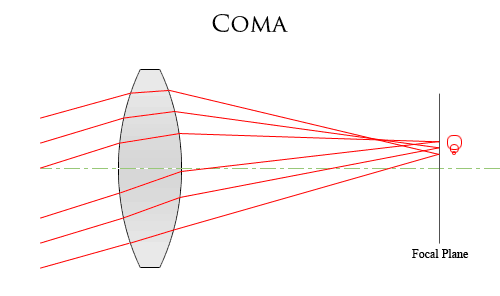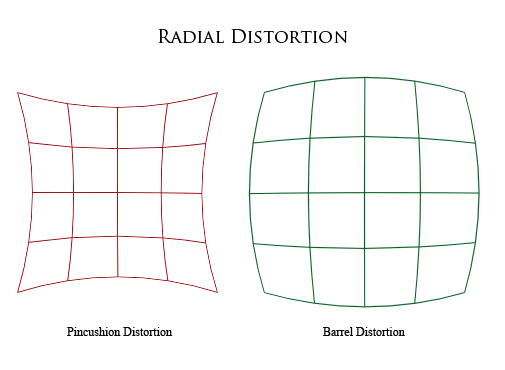Fundamentals of Light & Optics
There are many variations on the basic types of lenses each designed for a specific task of controlling the transmission of light through the system. A lens forms part of an optical transmission system, as with any type of transmission system, a degree of distortion will be introduced. Distortion can also be explained as the difference (or amount of change) of the output signal from the input (origional) signal.
In optics, distortion is known as aberration, and is the inability of a lens to form a perfect image; i.e the image formed by the lens will have some distortion artefacts.
We will now look at the important types of lens aberration that affect image quality.

Fig 3.3 illustrates an ideal lens where all of the incoming light rays converge to a single focal point. A single lens is , although the design of an optical system can contribute to successfully reduce and minimise aberration.
As we studied previously, white light is made up of many colours or wavelengths. Red light (long wavelength) has less energy than Blue light (short wavelength), and therefore when passing through a medium, the refractive index will cause the light waves to slow down, Red is bent or refracted the least, and blue is refracted the most.

When light passes through a lens, refraction of light will occur. When dealing with the ideal single convex lens model, we know that light rays are focused to a finite point. In reality due to refraction and dispersion, the lens will not be able to focus the different wavelengths at the exact same point, as the focal length of a lens is dependant on the refractive index of the lens material. Fig 3.4 shows how the different wavelengths of light are focused at different points.
This type of effect is known as chromatic aberration. The result of chromatic aberration is that the image produced by the lens will have a coloured boundary that seperates high contrast areas. Chromatic aberration also causes a loss of sharpness (i.e blurred image).
Chromatic aberration is also subdivided into two types;
Axial (longitudinal) - The wavelengths of light are focused at different focal points (distances) from the lens (focus shift).
Transverse (lateral) - The wavelengths of light are focused at different points on the focal plane
Referring again to Fig 3.4, axial CA is represented by the intersection of the light rays along the central axis and transverse CA is represented by the separated points above and below the central axis.
Chromatic aberration can be controlled using specialised coatings, lenses made from low dispersion materials such as flourite, or by using achromatic doublets, a Lens which is constructed using two separate lenses of different refractive index materials bonded together.
An aberration-free (ideal) lens will focus light to one point, although in practice, this is not the case. Typically for single lenses, light rays that enter the lens will refract differently as the distance increases from the optical axis. Spherical aberration arises from the spherical surface of the optical element.
Spherical aberration affects the quality of the image produced by the optical system.

Light rays closest (or parallel) to the optical axis are known as paraxial rays, and these will be focused by the lens on the (paraxial) focal plane. Light rays entering the edge of the lens are known as marginal rays.
Paraxial light rays are focused to a point fartherst from the lens and marginal rays are focused to a point closest to the lens.
The difference between the closest focal point (to the lens) and the fartherst point is known as Longitudinal Spherical Aberration (LSA). The height difference between the paraxial focal point to the point where the marginal rays intercept the paraxial focal plane is known as Transverse Spherial Aberration (TSA).
Fig 3.5 illustrates spherical aberration.
Lens coma is a cause of imperfections or optical design of a lens which results in distortion and burring of the image.
The surface of a lens exhibits different degrees of magnification across the aperture and when off-axis point sources are imaged by the lens, a characteristic ring-shape image known as a comatic circle is formed in the focal plane. An off-axis image point is not sharp and appears as a comet-like flare.
In photography, many lenses at their maximum apeture (e.g f/1.4) will produce slighly soft (blurred) images, therefore we typically stop-down a lens to improve the sharpness of the image. What we are doing is reducing the marginal rays (and off-axis image points) entering the lens. Using the apeture control to cover the outer areas of the lens, we can effectivly reduce the negative effects caused by comatic aberration.

Distortion in simple terms, is the bending of straight lines (from the scene) in the projected image.
Referring to Fig 3.7, the two main types of distortion that are observed in optical systems: Pincushion Distortion and Barrel Distortion. A third type is a mixture of barrel and pincushion known as Mustache Distortion.
These types of distortions typically can be corrected using software algorithms.

Astigmatism is another form of aberration that is caused when light rays through an optical system propagate in two perpendicular planes.
Astigmatism becomes more obvious the greater the angle of the object points from the optical axis, this gives rise to two distinct focal points appearing as a line or ellipse rather than a defined point.
Depending on the angle of the off-axis rays entering the optical system, the image will be orientated in either the tangential plane (meridional) or sagittal plane (horizontal).

Fig 3.8 illustrates third-order astigmatism; however, a second form of astigmatism occurs with optical systems that are misaligned or not symmetrical around the optical axis (this may be by design or due to flaws within the optical system).
This concludes our journey through the fundamentals of light and optics.
The field of optics is one of the most important areas in physics, we have only but scratched the surface, however, hopefully this overview has provided some information to understand some basic principles and understanding of light and optics.
- Flavio Spedalieri, December 2020 -
This Document Complies to W3C XHTML 1.0 Strict Standards



